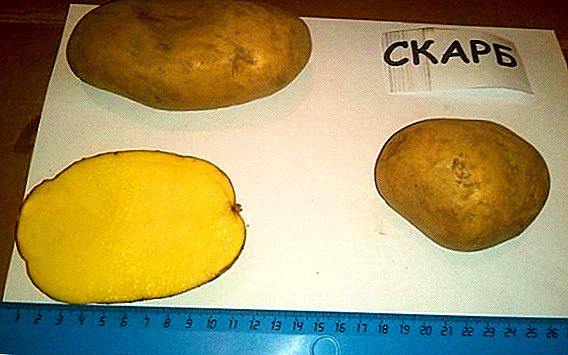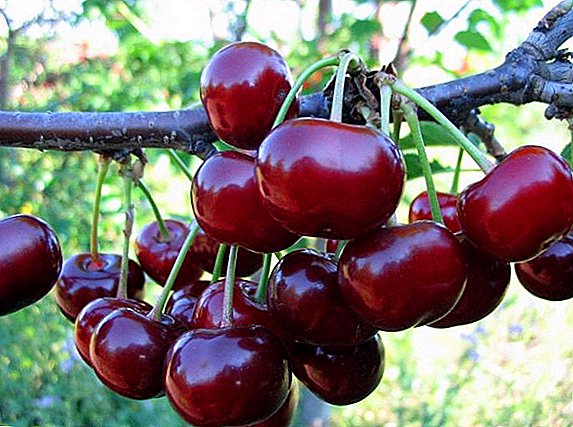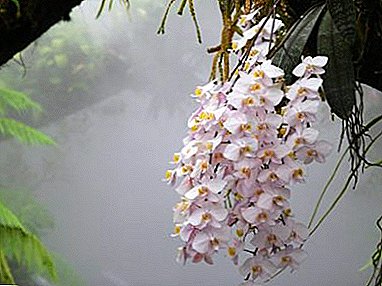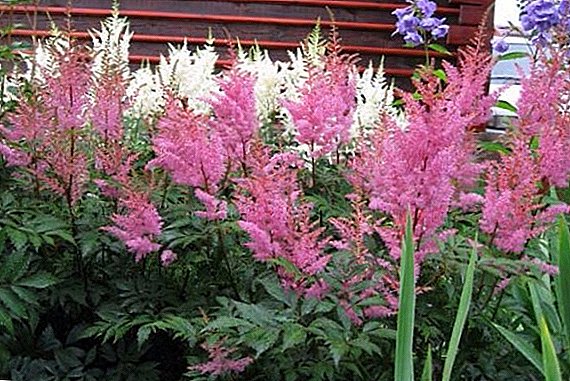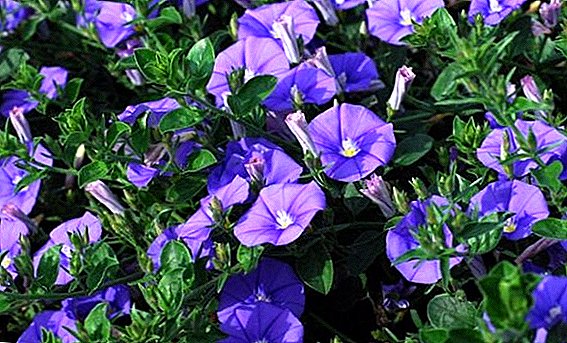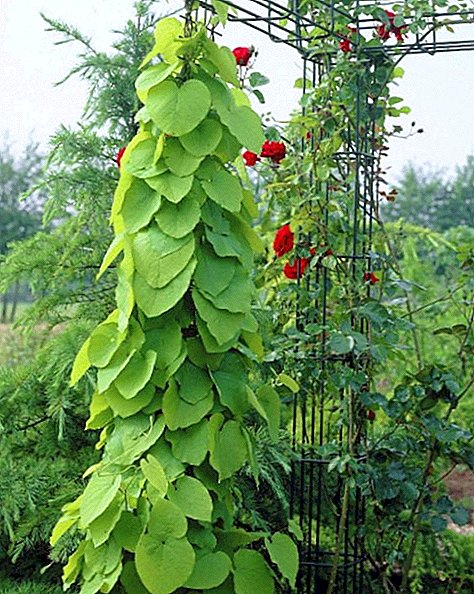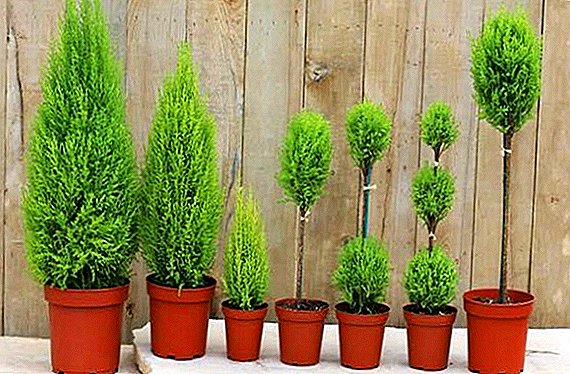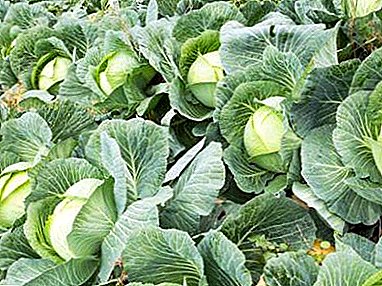
In the late spring and early summer, all winter vegetable stocks are running out a little, or these pickles get bored during the winter.
Unfortunately, except for radishes and greens in the gardens early nothing grows. But there is a real salvation for lovers of fresh vegetables - early cabbage. If you plant it in March, then by June you can harvest the first harvest.
Well, if this cabbage is unpretentious in the care and will have a high yield. Such a variety is Nozomi, which will be discussed in the article. You will also learn how to care for such cabbage.
Botanical description and appearance
This variety is considered one of the earliest ripening. Its growing season lasts within two months.
Heads of corn are usually formed with a weight of about 2.5 kilograms. Most of the fruits have an attractive presentation (almost 90%), and the cabbage can not be cut for a long time, and the presentation of this will not be lost.
Reference! This hybrid variety easily carries long shipments.
Characteristic variety
- Leafy plates of a gray-green shade, as if slightly bubbly. The edges of the leaves are characterized by a small wave, they can notice a weak wax coating.
- Heads of a rounded shape.
- The density of the vegetable is estimated at 4.5 points out of 5 possible.
- In the section, cabbages are characterized by a light yellow shade.
- The outer stalk is long, and the inner stub is shortened.
- Cabbage is resistant to cracking, even despite intensive watering.
- The average weight of a vegetable is 2 kilograms.
- Reviews on the taste of this variety only positive.
History of
 Nozomi variety was obtained by French breeders Sakata Vegetables Europe. In Russia, it was entered into the state register in 2007.
Nozomi variety was obtained by French breeders Sakata Vegetables Europe. In Russia, it was entered into the state register in 2007.
Sometimes, buying seeds, gardeners may notice on the packaging that the seed was made in Japan. There is nothing surprising. The fact is that until some time the company "Sakata" was in Japan, later opened its branch in France, and over time the company’s office moved there.
Initially, Nozomi seeds recommended for cultivation in the North Caucasus regionhowever, they are perfectly acclimatized in other parts of our country.
Distinctive features
The main distinctive feature of Nozomi is its time of ripening. As for cabbage, this is the ultimate minimum. And also this variety is more popular than others, thanks to its high yield indicators - 315 c / ha.
Advantages and disadvantages
From the advantages we can distinguish the following:
- Rapid ripening.
- A bountiful harvest.
- Immunity to many diseases.
- Unpretentious care.
- Resistant to slight freezing.
- Does not crack when excess moisture.
- Excellent for sale, as it has excellent taste and appearance.
By cons Nozomi include the following items:
- Short storage.
- Suitable for fresh consumption.
Detailed instructions for planting and care
Seed cost
You can buy such a variety in any store that specializes in selling seeds. And now this service is available in online stores. Nozomi seeds are worth about 1900 rubles for 2500 pieces.
When to sow?
 Sow seeds for seedlings at the end of February and beginning of March.. It is better to do it in a street greenhouse - in this case, the seedlings will be strong. But in the case of sowing at home the seedlings will be too tall and thin.
Sow seeds for seedlings at the end of February and beginning of March.. It is better to do it in a street greenhouse - in this case, the seedlings will be strong. But in the case of sowing at home the seedlings will be too tall and thin.
They move small shoots into the open ground at a time when the weather outside the window is a little settled down - the temperature of the air at night should not fall below +10 degrees. In case of frosts, seedlings should be covered with foil. However, if this does not succeed, the cabbage can survive a slight drop in temperature.
Before planting, seedlings should be hardened.. To do this, periodically remove the film, which she covered.
Choosing a place
Since Nozomi grows in early spring, it is better to choose the most illuminated place for planting seedlings. There should be no trees or other objects that create a shadow. It is also necessary to ensure that the cabbage is well ventilated, but it does not produce drafts - this is the most dangerous factor for young cabbage.
What should be the soil?
The soil should be looseIt is advisable to feed it with humus or manure before winter. But you can do it at the very beginning of spring. Well, if after the summer season the garden will be dug over, it must also be done before planting vegetables. This will allow the earth to become more breathable and will also eliminate weeds.
Landing process
First you need to figure out when it is already possible to plant seedlings in open ground. It depends not only on the weather outside the window and the numbers on the calendar, but also on the state of the cabbage itself. Seedlings should reach a height of at least 15-20 centimeters, have a minimum of 7-8 leaves, as well as a good root system.
For the landing you need to prepare the wells. Their depth should be approximately 15-20 centimeters. The planting pattern is standard and familiar to many gardeners - 50 * 50. Such a condition is necessary in order for each seedling to reach the sun fully, as well as to ensure good ventilation.
Step-by-step instruction:
- In the wells put mineral fertilizer.
- Get seedlings, examine its roots for the presence of pests, dip them in a growth stimulator.
- Deepen the seedlings in the ground before the start of growth of cotyledon leaves.
- Sprinkle the roots with a lightly moistened soil, and then ram it a little so that the seedlings stand steadily.
Temperature
The minimum temperature indicators after planting and strengthening of seedlings should not fall below 14 degrees Celsius. If the air is cooler than this minimum, it is recommended to cover the cabbage with a special film.
Usually in spring and early summer the weather is not hot, but if the temperature rises beyond 25 degrees, it is better to sprinkle cabbage more often so that its leaves do not dry out.
Watering
 Water is needed to form juicy and dense leaves. On 1 square meter contribute from 8 to 13 liters of distilled water of average temperature.
Water is needed to form juicy and dense leaves. On 1 square meter contribute from 8 to 13 liters of distilled water of average temperature.
Watering is done every two to three days.. Especially cabbage needs water during the period of heading and during dry weather.
In rainy weather there is no need for soil moistening. 15-20 days before harvesting, watering is slightly reduced to prevent head cracking. Proper watering is very important for the growth of the vegetable and its further storage after harvest.
Top dressing
Application of fertilizer increases the quantity and quality of the crop. Nozomi for the entire growth period fertilized three times:
- 10-15 days after landing in open ground. For this purpose, manure will perfectly suit (it is diluted with water in the ratio 1: 5) and bird droppings (proportions 1:10). The bucket goes to 8-10 bushes. Urea can be used.
- During the setting of heads. Use the same dressing, in which you can add another 1-2 tablespoons of wood ash.
- 25 days after the second. Fertilizer is used the same.
Hilling
After each watering, the soil is loosened for about 5 cm. This does not allow a dry crust to form and promotes free air penetration. During this process, we must immediately get rid of weeds.
Harvesting
2 months after planting seedlings in open ground Nozomi is ready for harvesting. At the same time, the fruit on the leg is carefully cut with a sharp knife. If the gardener is delayed in harvesting for 5-8 days, nothing bad will happen to the cabbage.
Crop storage
Since this variety is not stored for very long (about a couple of months), it is better to provide it with optimal conditions. It should be a dry, cool place that is well ventilated. It is advisable to store the crop in the cellar. But at the same time it needs to be examined for pests.
Diseases and pests
 The following pests can attack Nozomi:
The following pests can attack Nozomi:
- cruciferous flea;
- cabbage tree;
- cabbage moth;
- scoop.
To protect cabbage from such parasites, it is necessary to plant celery, carrots, dill or marigolds between rows. These plants deter pests.
This variety is subject to such diseases:
- black skin;
- kila;
- downy mildew.
You can deal with such ailments with Bordeaux liquid or lime mortar.
Prevention of various problems
In order for Nozomi not to attack diseases and pests, it is important to follow the rules of her care. even at the stage of growing seedlings (in this process, the most important thing is regular airing). After planting seedlings need to monitor the air temperature, lighting and soil conditions.
The variety described by us has become popular among gardeners due to a number of advantages. This is an affordable price of seeds, and a good yield, and a beautiful presentation.


